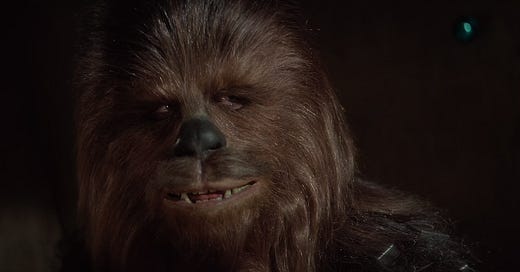Chewbacca
In A New Hope, Obi-Wan Kenobi and Luke Skywalker meet Chewbacca, the Wookiee copilot of the Millennium Falcon, in the Mos Eisley Cantina. Chewbacca's name suggests a combination of two words: the English "chew" and the Japanese baka ("fool").
It is appropriate that the word "chew," connoting eating, is the first part of Chewbacca's name. As a furry, beastlike creature who communicates by growling, Chewbacca is symbolically associated with what C.S. Lewis refers to as "the belly" – the appetitive, instinctive, animalistic part of the soul, which is concerned with material goods like food and money. It is appropriate that Chewbacca is first introduced in a cantina, an establishment that exists to satisfy the appetites; and in Return of the Jedi, Han Solo chides Chewie for "always thinking with [his] stomach."
The second part of Chewbacca's name, "bacca," connotes the Japanese baka ("fool"). We might think of Tahei and Matashichi, the pair of fools in Akira Kurosawa's classic Japanese film The Hidden Fortress, a major influence on A New Hope. Chewbacca and Han Solo, like Tahei and Matashichi, are a pair of down-on-their-luck fools (or baka) who get roped into an adventure to help a princess even though they are only really out to make some money.
The Jungian archetype of the fool is not truly stupid, but hides a kind of simple wisdom behind the appearance of folly. Chewbacca's perceptiveness is often underestimated, and he has good moral instincts as well. At the end of A New Hope, Han is redeemed from his selfish materialism, returning with the Millennium Falcon to save Luke, because he listens to Chewbacca.
EXPLORE FURTHER…
Films: Episode IV: A New Hope
GO DEEPER INTO THE ARCHIVES…
Concepts: animals / appetite / materialism / names / wisdom and foolishness
Interpretive Tools: Tripartite Soul Theory
READ MORE ABOUT…
Follow The Jedi Archives on…




